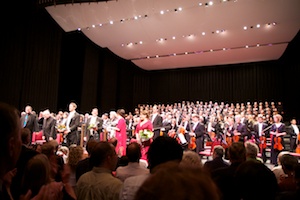Rosa woke up before me this morning and started her morning routine (doing her hair, picking out clothes).
Eventually I began to stir. She came back into the bedroom and opened the curtains, letting the sunlight flood in.
The sunlight was warm on my skin.
And I began to think about how incredible that was. The Sun is 150 million kilometres away. Only the most inconceivably small amount of photons that the Sun produces reached across that distance to alight upon my drowsy form.
Because I like numbers, here’s the deal. My arm is about 70 square centimetres, or 0.07 metres square. The total area of a sphere is ![]() That means that the area of the sphere of solar radiation at the distance of Earth’s orbit is 4 x π x 149,598,000 kilometres x 149,598,000 kilometres. That’s 2.8 x 10^17 square kilometres or 2.8 x 10^23 square metres. My arm was therefore receiving 0.000,000,000,000,000,000,000,024,89 percent (2.489 x 10^-23 %) of the photons that the Sun is producing, and even that infinitesimal amount was enough to warm my arm and wake me from my slumber.
That means that the area of the sphere of solar radiation at the distance of Earth’s orbit is 4 x π x 149,598,000 kilometres x 149,598,000 kilometres. That’s 2.8 x 10^17 square kilometres or 2.8 x 10^23 square metres. My arm was therefore receiving 0.000,000,000,000,000,000,000,024,89 percent (2.489 x 10^-23 %) of the photons that the Sun is producing, and even that infinitesimal amount was enough to warm my arm and wake me from my slumber.



